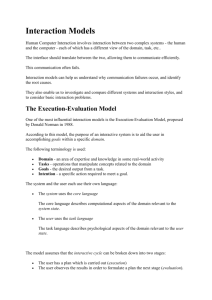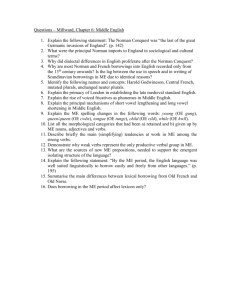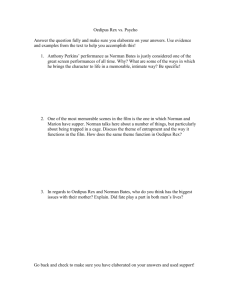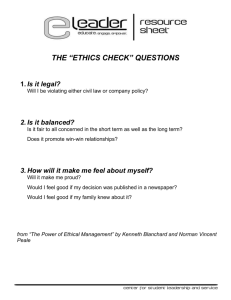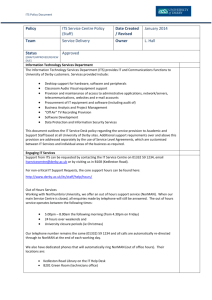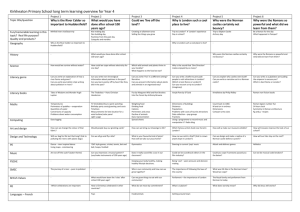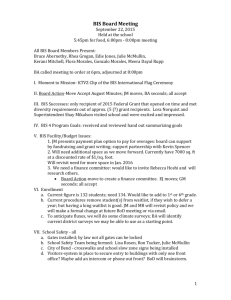Small Claims Court What Is Small Claims Court?
advertisement
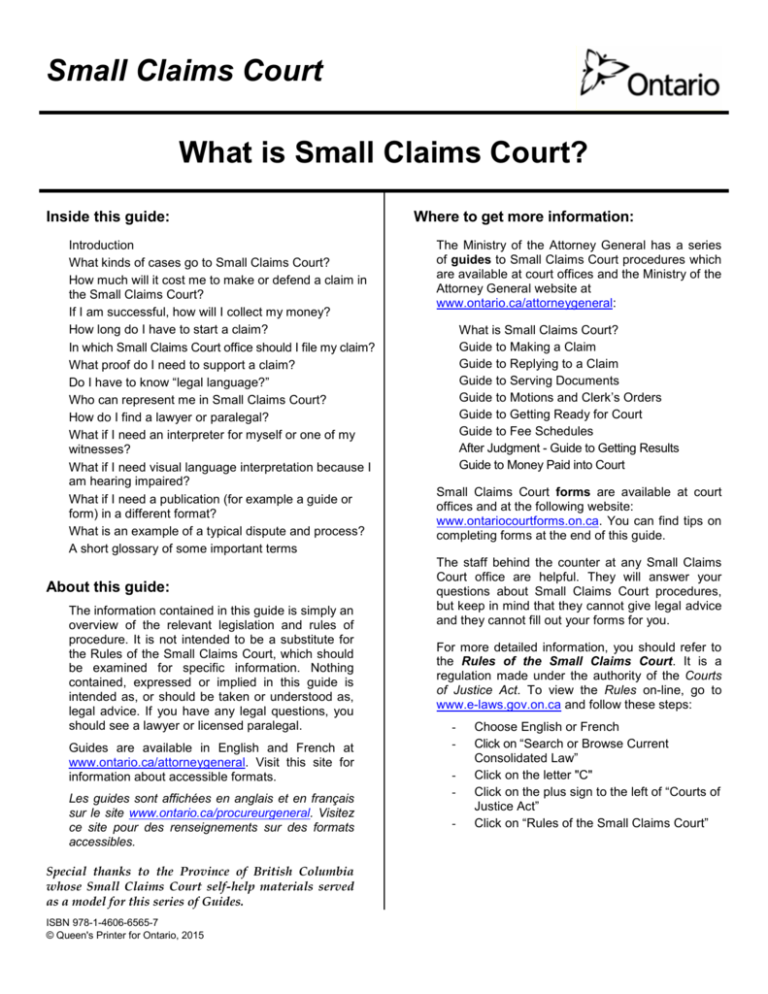
Small Claims Court What is Small Claims Court? Inside this guide: Introduction What kinds of cases go to Small Claims Court? How much will it cost me to make or defend a claim in the Small Claims Court? If I am successful, how will I collect my money? How long do I have to start a claim? In which Small Claims Court office should I file my claim? What proof do I need to support a claim? Do I have to know “legal language?” Who can represent me in Small Claims Court? How do I find a lawyer or paralegal? What if I need an interpreter for myself or one of my witnesses? What if I need visual language interpretation because I am hearing impaired? What if I need a publication (for example a guide or form) in a different format? What is an example of a typical dispute and process? A short glossary of some important terms About this guide: The information contained in this guide is simply an overview of the relevant legislation and rules of procedure. It is not intended to be a substitute for the Rules of the Small Claims Court, which should be examined for specific information. Nothing contained, expressed or implied in this guide is intended as, or should be taken or understood as, legal advice. If you have any legal questions, you should see a lawyer or licensed paralegal. Guides are available in English and French at www.ontario.ca/attorneygeneral. Visit this site for information about accessible formats. Les guides sont affichées en anglais et en français sur le site www.ontario.ca/procureurgeneral. Visitez ce site pour des renseignements sur des formats accessibles. Special thanks to the Province of British Columbia whose Small Claims Court self-help materials served as a model for this series of Guides. ISBN 978-1-4606-6565-7 © Queen's Printer for Ontario, 2015 Where to get more information: The Ministry of the Attorney General has a series of guides to Small Claims Court procedures which are available at court offices and the Ministry of the Attorney General website at www.ontario.ca/attorneygeneral: What is Small Claims Court? Guide to Making a Claim Guide to Replying to a Claim Guide to Serving Documents Guide to Motions and Clerk’s Orders Guide to Getting Ready for Court Guide to Fee Schedules After Judgment - Guide to Getting Results Guide to Money Paid into Court Small Claims Court forms are available at court offices and at the following website: www.ontariocourtforms.on.ca. You can find tips on completing forms at the end of this guide. The staff behind the counter at any Small Claims Court office are helpful. They will answer your questions about Small Claims Court procedures, but keep in mind that they cannot give legal advice and they cannot fill out your forms for you. For more detailed information, you should refer to the Rules of the Small Claims Court. It is a regulation made under the authority of the Courts of Justice Act. To view the Rules on-line, go to www.e-laws.gov.on.ca and follow these steps: - Choose English or French Click on “Search or Browse Current Consolidated Law” Click on the letter "C" Click on the plus sign to the left of “Courts of Justice Act” Click on “Rules of the Small Claims Court” Introduction In Ontario, the Small Claims Court is a branch of the Superior Court of Justice. It deals with civil disputes of a monetary value of up to $25,000 (Canadian). Small Claims Court has simplified rules and procedures. For example, the forms in Small Claims Court use a fill-in-the-blank style. We encourage you to read this guide if you are thinking of making a claim in Small Claims Court, or if you are already involved in a case. It answers questions about the court and provides examples of what happens in typical Small Claims Court cases. More detailed information about Small Claims Court procedures is available. Refer to the list of guides at the front of this guide. What kinds of cases go to Small Claims Court? The Small Claims Court can handle any action for the payment of money or the recovery of possession of personal property where the amount claimed does not exceed $25,000, excluding interest and costs such as court fees. This includes the value of all goods that the plaintiff is asking for in total, no matter how many defendants there are. If the amount of your claim is more than $25,000, you can still choose to use Small Claims Court. However, you will have to give up the amount of money over $25,000, as well as any future right to get this money in any other court. You cannot divide the amount of money you are claiming into separate cases. You cannot, for example, divide $30,000 into a $25,000 claim and a $5,000 claim in order to have the total amount dealt with in two cases. Examples of claims that can be filed in the Small Claims Court include: claims for money owed under an agreement: - unpaid accounts for goods or services sold and delivered - unpaid loans - unpaid rent - NSF cheques; and claims for damages: - property damage - clothes damaged by a dry cleaner - personal injuries - breach of contract How much will it cost me to make or defend a claim in the Small Claims Court? You must pay a fee to file a claim or defence in Small Claims Court and for most steps in a proceeding, such as filing a motion, requesting a trial date, and taking steps to enforce a judgment. The number of steps in a proceeding varies from case to case. There are also fees and allowances that you must pay to witnesses you have summoned for their attendance and travel to court. In addition, you will have to pay for any interpreters you or your witnesses require, other than bilingual (English or French) interpretation and visual language interpretation, unless your fees are waived (see below). What is Small Claims Court? 2 A party – often the successful party – can ask that the other party be ordered to pay his or her costs, such as court fees. The Ontario Government introduced a fee waiver certificate for persons who may be denied access to justice because of their financial circumstances. Refer to the “Guide to Fee Schedules” for more information about fees and fee waiver. If I am successful, how will I collect my money? It is important to remember that a judgment is an order of the court; it is not a guarantee of payment. If you obtain a judgment in your favour, and the debtor fails to pay you as required by the judgment, you may have to take steps to enforce (collect) the judgment. In order for you to collect, the person or business must have one of the following: - money, - assets that can be sold, or - a debt owed to the debtor by another person (for example, a bank account or employment income) that can be garnished. Please refer to “After Judgment – Guide to Getting Results” for more information. How long do I have to start a claim? There may be a time limit to how long you can wait before making a claim. If you are uncertain about what period of time applies in your case, you should consult a lawyer. In which Small Claims Court office should I file my claim? Deciding where to file your claim is an important decision. You must file your claim in the court office that satisfies any of the following criteria: - - the court in the territorial division where the cause of action arose (i.e. where the event took place or problem occurred); the court in the territorial division in which the defendant lives or carries on business (if there are several defendants, then it can be the court in the territorial division in which any one of them lives or carries on business); or at the court’s place of sitting that is nearest to the place where the defendant lives or carries on business (if there are several defendants, then it can be the court nearest to the place in which any one of them lives or carries on business). Example 1 Meera and Norman enter into a contract in Ottawa, Ontario. Norman has not fulfilled his portion of the contract and Meera decides to file a claim in Small Claims Court. Norman lives in Brockville, Ontario. Meera will need to determine whether she wishes to start the claim in the Ottawa Small Claims Court (where the problem occurred) or in the Brockville Small Claims Court (where the defendant lives). What is Small Claims Court? 3 What proof do I need to support a claim? You will have to prove your case. Consider what witnesses and/or documents (for example, contracts, NSF cheques, record of payments) you have to support you. If you do not have supporting documents (e.g. you entered into a verbal agreement) or witnesses, your claim may still be successful. However, if it is just your word against the other person's, it may be more difficult to prove your case. You will be required to write in the claim form a short, clear summary of the events that took place and the reasons you think you are entitled to a judgment (court order). Copies of documents that you intend to use to support your claim must be attached to the claim form if you decide to go ahead. Refer to the “Guide to Making a Claim” for more information. The other party is able to respond to your claim and may give evidence that will affect the judge's view of your entitlement. Do I have to know "legal language?" There are a few legal words that you will need to understand. At the end of this guide you will find a short glossary of some important terms. Who can represent me in Small Claims Court? Many litigants in Small Claims Court represent themselves. However, a party may also be represented in Small Claims Court by a lawyer or by a person authorized under the Law Society Act, R.S.O. 1990, G. L-8, such as a law student or a paralegal. If you wish to contact a paralegal in your area, you may consult the Paralegal Directory established by the Law Society of Upper Canada. How do I find a lawyer or paralegal? If you wish to consult an Ontario lawyer or licensed paralegal, you may contact the Law Society Referral Service operated by the Law Society of Upper Canada. The Law Society Referral Service can provide you with the name of a lawyer or paralegal in your area, who will provide a free initial consultation of up to 30 minutes to help determine your rights and options. If you would like to be referred to a lawyer or paralegal, you may submit a request to the Law Society Referral Service by completing the online request form at www.lawsocietyreferralservice.ca. A crisis line is available Monday to Friday, 9:00 am to 5:00 pm. The crisis line is intended for people who are unable to use the online service, such as those in custody, in a shelter, or in a remote community without access to the internet. The phone number for the crisis line is 416-947-5255 (toll free 1855-947-5255). Information about how to be referred to a lawyer or paralegal through the Law Society’s Referral Service is available at www.lsrs.info. You may also use the Law Society’s Lawyer and Paralegal Directory, which may be viewed at www.lawyerandparalegal.directory. What if I need an interpreter for myself or one of my witnesses? An interpreter translates communication from one language to another. Small Claims Court provides interpretation services for all court proceedings and written documents from English to French and French to English. If you or your witnesses will need language interpretation in court from French to English or English to French, notify the court office at the outset of the case. Interpretation from English or French to any other language must be arranged for, and paid by, the party who requires the interpretation. The interpreter must be accredited as being capable of performing that function. The court office will pay for ‘in-court’ interpretation in any language for individuals who qualify for fee waiver. For more information about fee waiver, refer to the “Guide to Fee Schedules.” What is Small Claims Court? 4 What if I need visual language interpretation because I am hearing impaired? If you have a hearing impairment and need an interpreter, you can make a request at the Small Claims Court office. The staff will first ask whether written communication would satisfy your needs. If written communication would not be satisfactory, then a visual language interpreter can be used. You can either bring an interpreter with you or ask to have one arranged for you. You may have to make an appointment to come back when an interpreter is available. The court will pay visual language interpreters the standard Ministry interpreter rate or a requested fee (whichever is less). What if I need a publication (for example a guide or form) in a different format? Section 7 of the Ontarians with Disabilities Act provides: “Within a reasonable time after receiving a request by or on behalf of a person with disabilities, the Government of Ontario shall make an Ontario Government publication available in a format that is accessible to the person, unless it is not technically feasible to do so.” If you want to request a publication in a different format, please contact Service Ontario Publications at: Service Ontario Publications 50 Grosvenor Street Toronto, ON M7A 1N8 Toll Free: 1-800-668-9938 TTY Toll Free: 1-800-268-7095 What is an example of a typical dispute and process? The example below represents a typical dispute (reasons for the claim) and provides an overview of the initial steps involved in Small Claims Court to help you to understand how it works. The procedures outlined include: - the claim, - the defence, - the settlement conference, and - the trial. The dispute Meera loaned Norman $2,000. He agreed to pay it back in six months. The due date arrived and he paid her $500 but that is all. She has tried writing and calling him, but he avoids her. Finally, she decides to sue him (file a claim) in Small Claims Court. What is Small Claims Court? 5 The claim The first thing Meera has to do is fill out a Small Claims Court Plaintiff’s Claim [Form 7A]. Instructions are included in the form. She can either mail the claim or take the claim into the court office personally to file it. There are advantages to attending the court office in person. Refer to the “Guide to Making a Claim” for more information. Meera claims $1,500 and interest at 10%. She decides to take the original claim form and supporting documents (the loan agreement and record of payments received), as well as one copy of the claim and supporting documents, to the Small Claims Court office. She pays the filing fee and the clerk assigns a court file number and stamps the forms. This is called "issuing" the claim. The clerk returns her copy of the claim and supporting documents to her. She must now make a photocopy of the claim form and supporting documents to serve on Norman. Meera hands the papers to Norman at his house. This is called “serving” the claim. Norman then has twenty (20) calendar days from the day he is served with the claim to file his defence. The defence Norman receives Meera’s claim but does not agree with it. He agrees he owes Meera money, but it was supposed to be a no-interest loan and now she says he agreed to pay 10% interest. Norman thought that $700 of the money she gave him was payment for repairs he did to her car. He has already repaid $500, so he believes he only owes her $800. Norman fills out a Defence [Form 9A]. In it he admits that he owes her $800 and indicates that he will pay her on the first of the month (which he does). He says $700 of the money Meera gave him was payment for repairs he did to her car. He denies that he owes any interest. He attaches a copy of the invoice he gave to Meera for the repair work. This leaves $700 and the interest claimed in dispute. He must now make a photocopy of the defence form and supporting documents to serve on Meera. Norman mails the papers to Meera at her house. This is called “serving” the defence. Norman takes the original defence form, one copy and an affidavit of service to the Small Claims Court office where Meera filed the claim (the address is located on the claim form). He files it and pays the fee for filing the defence. The clerk returns one copy of the defence to him for his records. The original is kept in the court file. Refer to the “Guide to Replying to a Claim” for more information. The settlement conference The next thing that happens is that Meera and Norman both get a notice in the mail from the court office telling them to come to a settlement conference (which should be scheduled to be heard within 90 days after Norman filed his defence). They will also receive a blank List of Proposed Witnesses [Form 13A] to complete, serve on each other, and file with the court at least 14 days before the settlement conference. If Meera and Norman wish to refer to any documents at trial (including any expert reports) that were not attached to the claim or defence, they must also serve each other with copies of these additional documents at least 14 days before the settlement conference. At the settlement conference, which is presided over by a judge, the parties discuss the case. Meera eventually agrees that the loan was supposed to be interest-free. But they cannot agree about the $700 for car repairs. There will have to be a trial about the $700 that they disagree on. Refer to the “Guide to Getting Ready for Court” for more information about settlement conferences. What is Small Claims Court? 6 Settlement before trial Meera and Norman keep talking after the settlement conference. They agree that he will pay her $300 at the end of the month to avoid the time and expense of going to trial. They fill out and sign a Terms of Settlement [Form 14D]. Norman fails to pay Meera as agreed. Meera could make a motion to ask a judge for an order that Norman pay her $300 based on the Terms of Settlement that Norman signed. Instead, Meera chooses to take Norman to trial for the full $700 that she thinks he owes her. The trial The trial occurs before a different judge than the judge that presided over the settlement conference. At the trial, Meera and Norman tell their own stories and then reply to what the other person says. They also call witnesses. The judge accepts the evidence presented by Meera's mechanic that Norman did not do all of the work he said he did. The judge's decision is that Norman must pay Meera $500. Refer to the “Guide to Getting Ready for Court” for more information about trials. After judgment Meera asks Norman for the $500 he owes her under the judgment. Norman says he does not have the money. Meera reads “After Judgment – Guide to Getting Results” and considers her options for enforcing the judgment. She decides that she will file a Notice of Garnishment to have a portion of Norman’s wages garnished and paid into court. A portion of his wages from his employer will continue to be garnished until his debt to her is paid. Consolidation order If Norman has other Small Claims Court judgments against him, he can ask for a consolidation order permitting him to combine the judgments under one order and allowing him to make payments in instalments. For information about consolidation orders, refer to “After Judgment – Guide to Getting Results.” What is Small Claims Court? 7 A short glossary of some important terms Here are some key definitions of words that you will need to understand if you are making or defending a claim in Small Claims Court. Affidavit: a written statement or declaration of facts that are sworn or affirmed to be true. Affidavit for Jurisdiction: a plaintiff’s sworn or affirmed written statement that he or she filed the claim: - - in the territorial division where the cause of action arose (i.e. where the event took place or problem occurred); at the court in the territorial division in which the defendant lives or carries on business (if there are several defendants, then it can be the court in the territorial division in which any one of them lives or carries on business); or at the court’s place of sitting that is nearest to the place where the defendant lives or carries on business (if there are several defendants, then it can be the court nearest to the place in which any one of them lives or carries on business). (Court addresses and phone numbers can be viewed online at: www.ontario.ca/attorneygeneral) Claim: the form used to make a demand in Small Claims Court for money or personal property owing. There is a plaintiff’s claim form and a defendant’s claim form. Consolidation Order: an order permitting a debtor who has more than one Small Claims Court judgment against him or her to combine the judgments under one order and make payments in instalments. Creditor: one to whom a debt is owed. Debtor: one who owes an obligation to another; for example, an obligation to pay money under a judgment. Defence: the form the defendant uses to reply to the claim. Defendant: the person who replies to the claim. The defendant may also make a claim against the plaintiff or some other third party. Deponent: a person making a statement under oath. Endorsement Record: a document on which a judge makes a written judgment or court order. What is Small Claims Court? 8 Express Agreement: an agreement that has specifically stated terms. Garnishee: a person who owes money to the debtor and is being directed to pay it to the court office for the creditor. Judgment: a decision made by a judge resolving a dispute. Generally, the decision is documented on an endorsement record. You can ask for a copy of an endorsement record at the court office. Liquidated Claim: a “liquidated” claim is a claim for a sum of money due under an express agreement where the amount is fixed and does not depend on an assessment by the court. Motion: a process used to make a request to a judge for an order during or after a proceeding. Order: a written decision made by a judge during the course of a proceeding. An order made by a judge resolving the dispute is also called a judgment. Generally, the decision is documented on an endorsement record. You can ask for a copy of an endorsement record at the court office. Party: a litigant, usually a plaintiff or defendant. Person: a human being or an entity (such as a corporation) that is recognized by law as having the rights and duties of a human being. Plaintiff: a person who makes a claim in Small Claims Court. Serving: serving a document means getting it to another person in whatever way the rules of court require. Unliquidated Claim: an “unliquidated” claim is a claim where the amount in dispute is not fixed under an express agreement and requires an assessment of damages by the court (for example, damage to property or a personal injury). Writ of Delivery: a court order to return personal property to its rightful owner. What is Small Claims Court? 9 Tips on Completing Forms in Small Claims Court 1. BE NEAT. These are court documents. All court forms must be typed, handwritten or printed legibly. It may cause delays if your forms cannot be read. Forms are available at court offices and at the following website: www.ontariocourtforms.on.ca. 2. How to COUNT DAYS FOR TIMELINES in the Rules of the Small Claims Court: When calculating timelines in the Rules, count the days by excluding the first day and including the last day of the period; if the last day of the period of time falls on a holiday, the period ends on the next day that is not a holiday. The court can order, or the parties can consent to, the shortening or lengthening of the time prescribed by the Rules. Holidays include: - any Saturday or Sunday New Year’s Day Family Day Good Friday Easter Monday Victoria Day - Canada Day Civic Holiday Labour Day Thanksgiving Day Remembrance Day Christmas Day - Boxing Day - any special holiday proclaimed by the Governor General or the Lieutenant Governor NOTE: If New Year’s Day, Canada Day or Remembrance Day falls on a Saturday or Sunday, the following Monday is a holiday. If Christmas Day falls on a Saturday or Sunday the following Monday and Tuesday are holidays, and if Christmas Day falls on a Friday, the following Monday is a holiday. 3. At the top of the forms, fill in the NAME AND ADDRESS OF THE COURT where you are filing the documents. 4. Once court staff provides a COURT FILE NUMBER, make sure it is written on the upper right-hand corner of ALL your documents. 5. Bring enough COPIES of your completed forms to the court office. Usually you will require one copy for each party who must be served and one copy for your own records. In most cases, the court will keep the original form. There is a fee to have copies made at the court office. Refer to the “Guide to Fee Schedules” for more information. 6. COURT FEES must be paid to issue and file specific documents. Refer to the “Guide to Fee Schedules” for more information. Fees are payable in Canadian funds, and can be paid by cash, cheque or money order payable to the Minister of Finance. If you cannot afford to pay court filing or enforcement fees, you may request a fee waiver. The fee waiver applies to most fees in Small Claims Court proceedings. More information about fee waiver is available at any court office and on the Ministry of the Attorney General website at www.ontario.ca/attorneygeneral. 7. An AFFIDAVIT can be sworn or affirmed before: - a Small Claims Court staff member who is a commissioner for taking affidavits (there is no fee for this service); - a lawyer or paralegal licensed by the Law Society of Upper Canada; - a notary public; or - a person who has been appointed a commissioner for taking affidavits. These individuals are authorized to commission oaths. You should come to the commissioner with identification and the unsigned document. The commissioner will ask you to swear or affirm that the information in the affidavit is true and will ask you to sign the affidavit. The affidavit must be signed in front of the commissioner, since they will certify that it was sworn or affirmed in their presence. NOTE: It is a criminal offence to swear or affirm an affidavit you know is false. 8. If your ADDRESS FOR SERVICE changes, you must serve written notice of the change on the court and all other parties within seven (7) days after the change takes place. What is Small Claims Court? 10 Any Comments? Your feedback is important. Tell us how we can we help you better by taking a moment to comment on this Guide. Put your response in the Customer Comment Box at any Small Claims Court location. Was this Guide helpful to you? Yes No Why? What can we do to make this Guide better? Thank you! Your feedback is requested to help us improve these guides. Please do not provide any personal information. What is Small Claims Court? 11

